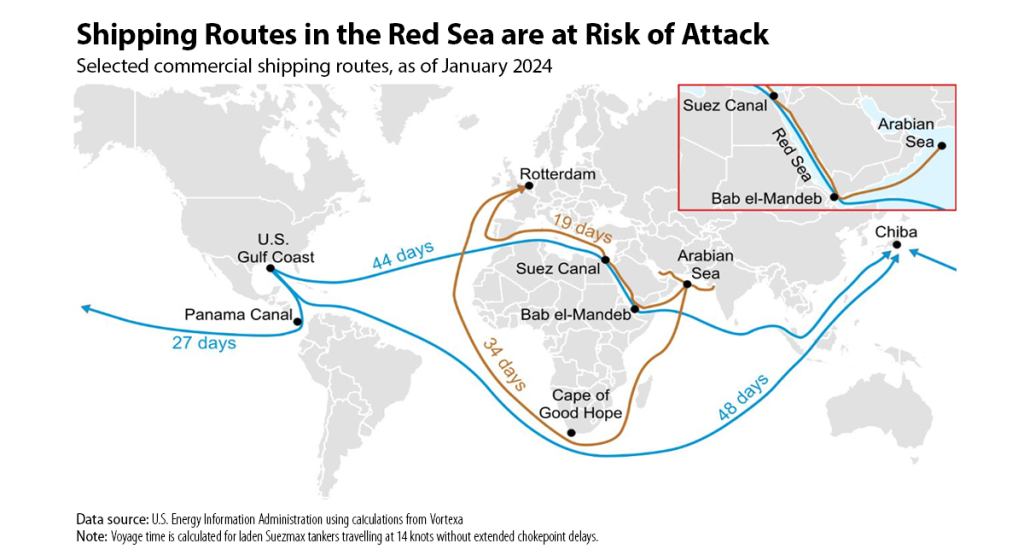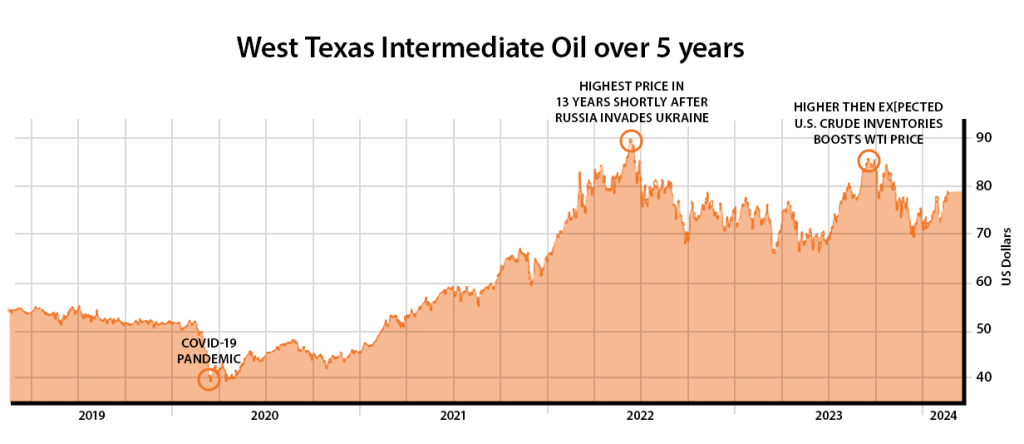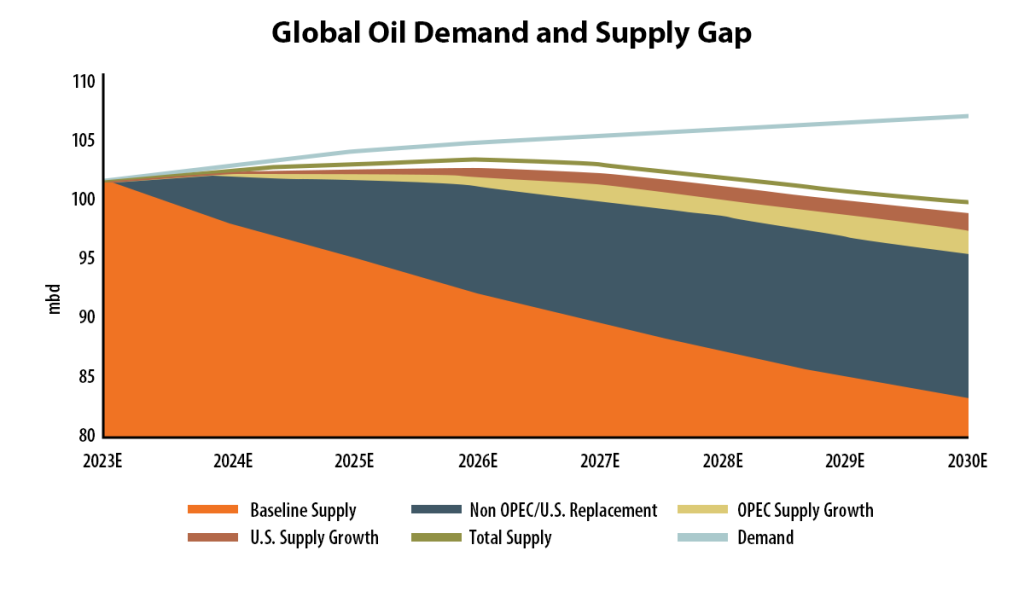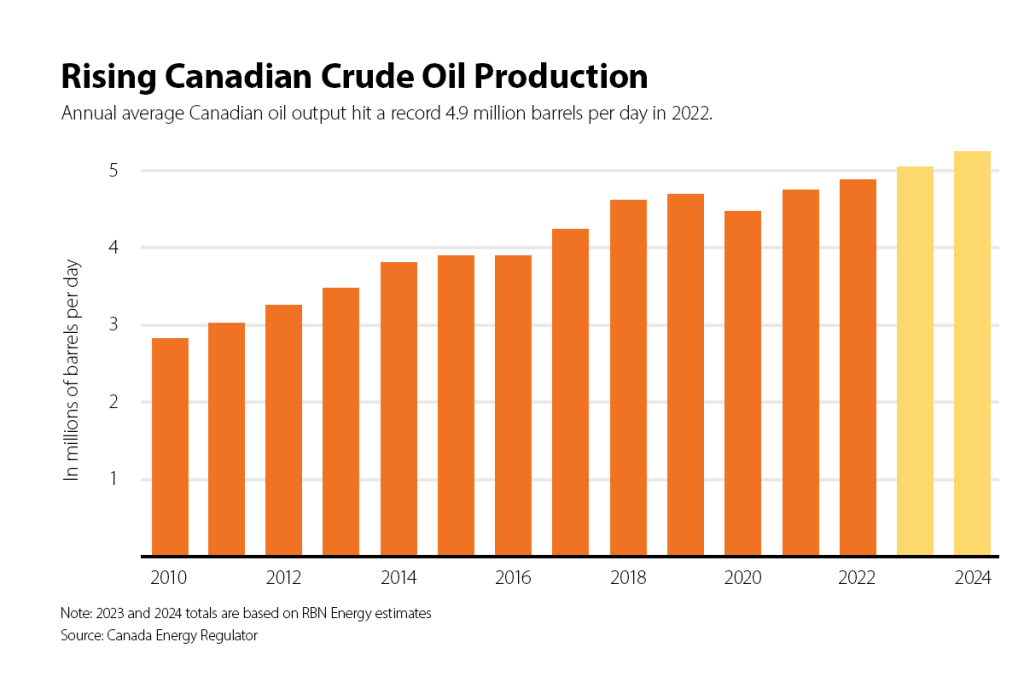Over the past five years, the price of crude oil has seen many price fluctuations. Investors have seen it go from lows amid a global pandemic, to a price spike spurred by supply constraints as a result of Russia’s invasion of Ukraine. In the opening months of the year, the price of oil has been supported by the ongoing conflict in the Middle East spilling over into nearby shipping lanes, supply disruptions and initial indicators of robust oil market fundamentals. The extent of global shipping disruptions can be seen in the chart below:

SUPPLY & DEMAND
For the year-to-date, the North American benchmark West Texas Intermediate (WTI) oil has been trading between the US$70-US$76 range. Historically, oil prices tend to peak around April and May in line with demand for both gasoline from North America’s driving season and refined distillate products – which presents a potential buying opportunity for investors.

The world is facing a persistent shortfall in oil supply compared to anticipated demand. Current daily global oil consumption stands at around 100 million barrels per day (bpd), according to a research from J.P. Morgan. Following recent cuts from the Organization of the Petroleum Exporting Countries (OPEC), the disparity between the demand for oil and its production is projected to widen, which could bolster oil prices. The following chart illustrates the gap between oil supply and oil demand.

ENERGY OUTLOOK
OPEC forecasts that world oil demand will rise by 2.25 million bpd this year and by 1.85 million bpd in 2025.
“Global economic growth remains robust. Further upside potential could materialize in all major Organization for Economic Cooperation and Development (OECD) and non-OECD economies,” OPEC said in its report.
Within OPEC, the world’s biggest oil producer is Saudi Aramco. Late last year, the Saudi company abandoned plans to boost oil production, which could have supply implications in the coming months, according to analysts.
In its most recent forecast, the International Energy Agency (IEA) indicated that world supply growth in 2024 will exceed demand growth. It increased its growth projections for demand by 180,000 bpd. Overall, the IEA’s demand forecast is lower than OPEC’s projection.
The U.S. Department of Energy’s Energy Information Administration (EIA) collects, analyzes, and disseminates energy data. It’s expecting crude oil prices to rise into the mid-US$80 per barrel range in the coming months with downward price pressures emerging in the second quarter of the year as global oil inventories increase.
You can read the latest short-term energy outlook here. Deloitte Canada predicts the price of WTI will average around US$72 per barrel in 2024, which is almost 30% below the record price set in 2022 when Russia began its invasion of Ukraine. This could lead to Canadian oil companies spending less on their projects but consumers might see lower prices at gas stations. Canadian crude production jumped 87% between 2005 and 2019. Following a decline due to the COVID-19 pandemic, production reached almost 5 million bpd in 2022.

ENERGY INVESTING
On a seasonal basis, the energy sector tends to perform particularly well from late February to early May as the industry gears up for the North American driving season. It also tends to perform well from late July until late September, ahead of the winter.
There are different ways to invest in the energy sector to potentially benefit from the movement in the price of oil. Investors can buy individual stocks in oil companies or they can consider an oil-focused investment vehicle, such as an exchange traded fund (ETF).
ETF investing can offer potentially greater diversification than holding individual stocks, helping to reduce the risks associated with investing in just one or two companies.
Global X offers solutions that can help investors gain exposure to the energy sector. With a strong home investment bias, Canadians have historically favoured investing in the nation’s oil and gas industry. Representing a market capitalization of over $290 billion, the Canadian energy sector as measured by the S&P/TSX Energy Sector Index has returned close to 23% over the last three years.

AN INCOME-FOCUSED APPROACH TO CANADIAN ENERGY
The Global X Canadian Oil And Gas Equity Covered Call ETF (ENCC) (formerly Horizons Canadian Oil and Gas Equity Covered Call ETF) offers a value proposition for investors looking to gain exposure to the dividends offered by companies in Canada’s oil & gas sector while potentially generating an enhanced yield with the added benefit of a covered call overlay.
“From an equity investor standpoint, and looking at Energy as the underlying theme, it is important to acknowledge that our energy use is not going down; we are only using more energy and generating it in different ways,” says Naseem Husain, Senior Vice President and ETF Strategist at Global X.
“In this environment, I like the covered call space for Energy because it allows the investor to participate in the upside (and downside) of energy stocks while generating attractive premiums from the call writing activity.”
ENCC has a 14.41% annual distribution yield as of February 22, 2024. Based on current yields, a $10,000 investment in ENCC would result in an additional $1,441 annually from the combination of the attractive dividend and options income yield.
“Overall, I view the energy sector as in a mature phase of slow growth which can lead to the optimal environment for covered call investing where investors participate in the gradual rise in stock prices, but the price increases are not sharp enough to trigger the call options written, potentially leaving investor with the additional income as the options expire and the market returns,” Husain says.
The Case for Midstream Exposure
Should the price of oil continue to trade in a narrow range, the fee-based business model of midstream oil companies could provide generous dividends and potentially cushion against rising oil volatility and adverse price movements.
Energy pipeline companies potentially strike the best balance between risk-adjusted returns and upside growth potential from rising energy prices and offer:
- Potentially attractive dividend yields
- Lower correlation to negative price movements in crude oil and natural gas
- Historically lower volatility than the broader sector as service costs are fixed
- Revenue stream expectations for security holders due to lower capital expenditures
The Global X Pipelines & Energy Services Index ETF (HOG) (formerly Horizons Pipelines & Energy Services Index ETF) invests in several Canadian oil and gas companies active in the nation’s midstream energy sector. HOG seeks to replicate the performance of the Solactive Pipelines & Energy Services Index.
DISCLAIMERS
Commissions, management fees, and expenses all may be associated with an investment in products (the “Global X Funds”) managed by Global X Investments Canada Inc. The Global X Funds are not guaranteed, their values change frequently and past performance may not be repeated. Certain Global X Funds may have exposure to leveraged investment techniques that magnify gains and losses which may result in greater volatility in value and could be subject to aggressive investment risk and price volatility risk. Such risks are described in the prospectus. The Global X money market funds are not covered by the Canada Deposit Insurance Corporation, the Federal Deposit Insurance Corporation, or any other government deposit insurer. There can be no assurances that the money market fund will be able to maintain its net asset value per security at a constant amount or that the full amount of your investment in the Funds will be returned to you. Past performance may not be repeated. The prospectus contains important detailed information about the Global X Funds. Please read the relevant prospectus before investing.
Published February 26, 2024
Categories: Articles, Insights
Topics: Commodities, Gas, Oil